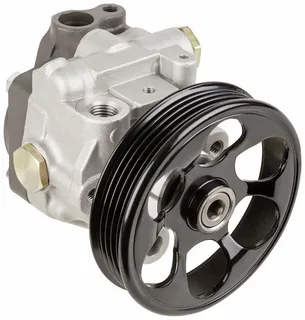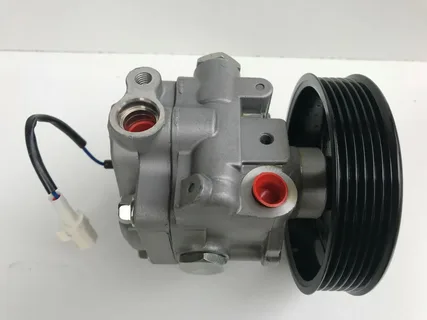Whether you’re a seasoned Subaru enthusiast or a new owner of the rugged and reliable Forester, regular maintenance is key to ensuring your vehicle performs at its best and extends its lifespan. One crucial component that often gets overlooked is the Forester Power Steering Pump system, which plays a vital role in providing smooth and effortless handling on a variety of terrain. However, neglecting to perform regular maintenance on this system can lead to premature wear, reduced performance, and even costly repairs.
Introduction to the Importance of Power Steering System Maintenance
The power steering system in your Subaru Forester is a crucial component that makes driving a breeze, especially in heavy traffic, stop-and-go situations, and when navigating tight parking spots. As you ease into the driver’s seat, you expect a smooth, effortless ride, thanks to the power steering system’s ability to reduce the effort required to steer the vehicle. But, like any other component, it’s not immune to wear and tear, and neglecting its maintenance can lead to premature failure, reduced performance, and even costly repairs.
Regular maintenance is essential to keep your power steering system in top shape, ensuring that your Forester continues to perform optimally and extend its lifespan. In this article, we’ll delve into the importance of maintaining your power steering system, highlighting the key signs of wear and tear, and provide practical tips on how to keep your system running smoothly, prolonging its life and saving you from the hassle and expense of repairs. By understanding the importance of power steering system maintenance, you’ll be better equipped to keep your Subaru Forester running smoothly, efficiently, and safely for years to come.
 What Is the Power Steering System and How Does It Work?
What Is the Power Steering System and How Does It Work?
The power steering system is a vital component of your Subaru Forester, responsible for making it easier to maneuver and control the vehicle, especially when driving at low speeds or in heavy traffic. This complex system consists of several key components, including the power steering pump, steering gear, and hydraulic fluid. The power steering pump is responsible for generating the hydraulic pressure needed to assist the driver’s steering efforts, while the steering gear is responsible for converting the hydraulic pressure into mechanical force that helps to turn the wheels. The hydraulic fluid, which is typically a type of oil or synthetic fluid, plays a crucial role in lubricating the system and enabling the smooth and efficient transfer of force between the pump and the steering gear.
Next, you’ll need to locate the drain plug, typically located at the bottom of the power steering pump. This plug will need to be removed using a socket wrench, allowing the old fluid to drain out. Be prepared for a mess, as the old fluid can be quite dirty and may spill or leak onto the surrounding area.
When the power steering system is functioning properly, it provides a smooth and quiet steering experience, making it easier to park, navigate tight spaces, and drive long distances. However, over time, the power steering system can become worn out and in need of maintenance. Neglecting to perform regular maintenance on the power steering system can lead to a range of problems, including decreased steering performance, increased wear on other components, and even complete system failure. In this blog post, we will explore the importance of regular maintenance and provide tips on how to extend the life of your Subaru Forester’s power steering system.
Signs of a Worn-Out Power Steering System
As you rumble down the road in your trusty Subaru Forester, you may not be paying attention to the subtle signs that your power steering system is crying out for attention. But, neglecting these warning signs can lead to a breakdown that leaves you stranded and stranded in the middle of nowhere. A worn-out power steering system is like a ticking time bomb, waiting to unleash its wrath on your vehicle.
Some common signs that your power steering system is nearing its expiration date include strange noises, such as whining, groaning, or screeching sounds, emanating from beneath the hood. You may also notice that your Forester’s steering feels heavier or more sluggish than usual, making it a chore to maneuver through tight spaces. Additionally, the power steering fluid may be leaking, or its level may be low, indicating that your system is in dire need of a top-off or replacement.
Furthermore, if you notice that your Forester’s steering wheel is no longer centered when you’re driving straight, or if it’s difficult to adjust the direction of your vehicle, it’s a clear indication that your power steering system is wearing out. Don’t wait until it’s too late – by recognizing these signs and addressing them promptly, you can extend the life of your power steering system and keep your Forester running smoothly for years to come.
The Importance of Regular Maintenance for Mazda Power Steering Pumps
The Mazda Power Steering Pumps system in your Subaru Forester is a complex and intricate network of components, working together in harmony to provide effortless control and maneuverability on the road. However, like all mechanical systems, it requires regular maintenance to function optimally and extend its lifespan. Neglecting routine maintenance can lead to premature wear and tear, causing costly repairs and even complete system failure.
Regular maintenance for power steering systems is essential to prevent issues such as worn-out seals, faulty pumps, and corroded hoses. A well-maintained system ensures that the components are properly lubricated, sealed, and secured, reducing the risk of leaks and damage. By scheduling regular maintenance checks, you can identify potential problems before they become major issues, saving you time, money, and the hassle of unexpected repairs.
Moreover, regular maintenance can also help to improve the overall performance of your Forester’s power steering system. A well-maintained system provides a smoother, more responsive driving experience, making it easier to navigate tight spaces and navigate rough roads. Additionally, regular maintenance can help to reduce the risk of system failure, which can leave you stranded on the side of the road, waiting for a tow or repair.
How to Inspect and Check the Power Steering Fluid
Locating the Reservoir:
Identify the power steering fluid reservoir, typically found on the driver’s side of the engine compartment. Remove the cap carefully to avoid spills.
Checking the Fluid Level:
Inspect the fluid level, ensuring it falls between the “MIN” and “MAX” marks on the reservoir. An inadequate level may indicate a leak or other issues that require attention.
Assessing Color and Consistency:
Observe the color and consistency of the fluid. Healthy fluid should appear light yellow or amber, while dark or murky fluid may indicate contamination or wear.
Evaluating Aroma:
Give the fluid a sniff to detect any unusual odors. Normal power steering fluid emits a slightly sweet aroma, while a strong, pungent odor may signal contamination or degradation.
Addressing Issues Promptly:
If you notice any abnormalities during the inspection, such as low fluid level, unusual color or consistency, or foul odor, it’s essential to address them promptly to prevent potential damage to the power steering system.
How to Change the Power Steering Fluid
As the lifeblood of your Subaru Forester’s power steering system, the power steering fluid plays a crucial role in maintaining the smooth and effortless operation of your vehicle’s steering. Over time, the fluid can become degraded and contaminated, leading to a loss of performance and potentially causing damage to the system’s components. This is why regular maintenance is essential to replacing the power steering fluid.
Changing the power steering fluid is a relatively simple process that can be done at home with the right tools and materials. It begins by locating the power steering fluid reservoir, usually found under the hood on the driver’s side. The reservoir is marked with a minimum and maximum level indicator, and the fluid level should be checked regularly to ensure it is within the recommended range.
Next, you’ll need to locate the drain plug, typically located at the bottom of the power steering pump. This plug will need to be removed using a socket wrench, allowing the old fluid to drain out. Be prepared for a mess, as the old fluid can be quite dirty and may spill or leak onto the surrounding area.
Tips for Preventing Power Steering System Failure
As you navigate the winding roads and rugged terrain that the Subaru Forester is renowned for, it’s easy to overlook the importance of regular maintenance for your power steering system. But neglecting this crucial component can have devastating consequences, leading to premature wear and tear, reduced fuel efficiency, and even complete system failure. To prevent this from happening, it’s essential to implement a proactive approach to maintenance. Here are some valuable tips to help you keep your power steering system in top shape:
First and foremost, always check your power steering fluid level regularly. A low level of fluid can cause excessive wear on your system’s components, leading to premature failure. Make sure to check the level when the engine is cold and the steering wheel is in the center position. A simple dipstick check can go a long way in preventing costly repairs down the line.
Another crucial aspect of maintenance is to address any leaks promptly. Power steering fluid leaks can be a sign of a more serious issue, such as a worn-out pump or seal, and can lead to a complete system failure if left unchecked. Keep an eye out for any signs of leakage, such as droplets forming under the hood or a faint scent of fluid.
Conclusion
As we’ve explored in this article, regular maintenance is the key to extending the life of your Forester’s power steering system. By following the simple yet effective steps outlined in this post, you can avoid costly repairs, ensure a smooth and quiet ride, and even improve your overall driving experience. By prioritizing the health of your power steering system, you’ll not only be saving money in the long run, but also enjoying a more reliable and responsive vehicle. So, don’t wait – take the first step today and give your Forester’s power steering system the TLC it deserves. Happy driving!
FAQs
How often should I check the power steering fluid in my Subaru Forester?
Check the power steering fluid level every 3 months or at each oil change.
What are the signs of a failing power steering pump?
Symptoms include whining or groaning noises when turning the wheel, difficulty steering, or fluid leaks under the vehicle.
What maintenance steps can help extend the life of my power steering pump?
Regularly check and top off the power steering fluid, use the correct type of fluid, and inspect for leaks and worn-out belts.
| Other Good Articles to Read |
| Blogs Rain |
| Cme Blog Spot |
| Garcias Blogs |
| Yyc Blogs |
| Guiade Blogs |
| Blogs-Hunt |
| Impact-Blog |
| Smarty Blogs |
| Ed Blog |
| Mo Blogs |
| Blogs Em |
| Blogs T |
| Related Business Listings |
| Contact Directory |
| Local Business Profiles |

